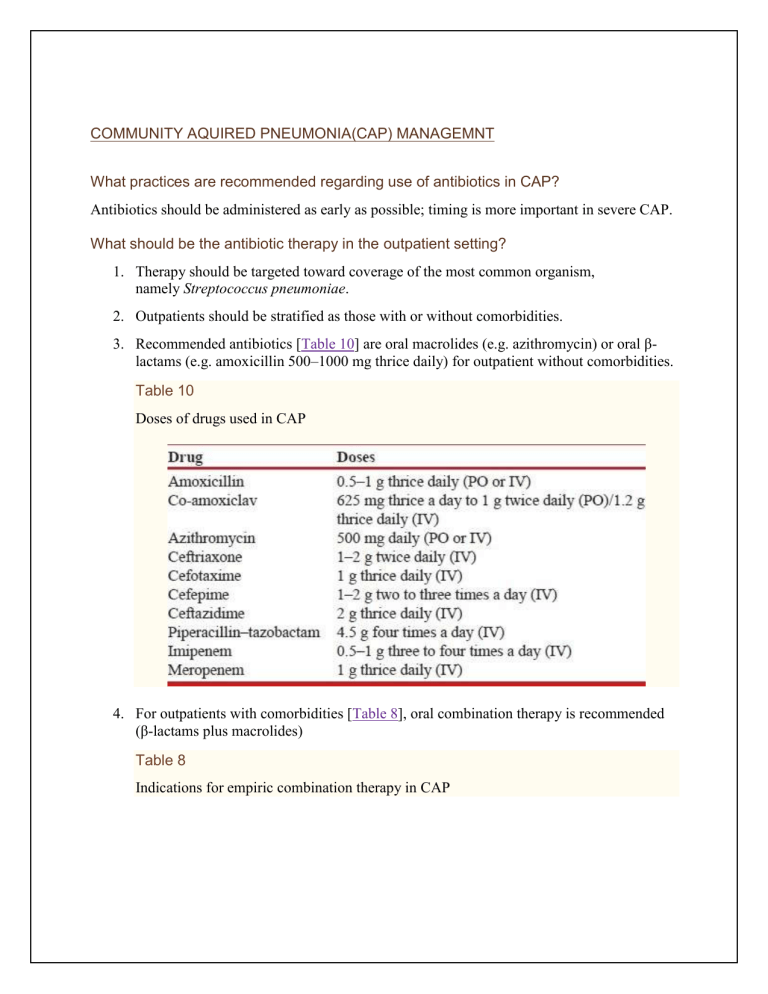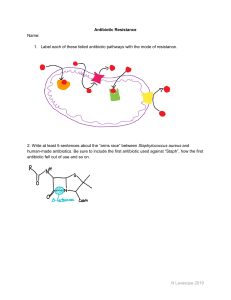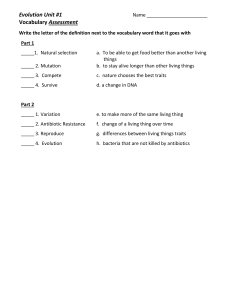
COMMUNITY AQUIRED PNEUMONIA(CAP) MANAGEMNT What practices are recommended regarding use of antibiotics in CAP? Antibiotics should be administered as early as possible; timing is more important in severe CAP. What should be the antibiotic therapy in the outpatient setting? 1. Therapy should be targeted toward coverage of the most common organism, namely Streptococcus pneumoniae. 2. Outpatients should be stratified as those with or without comorbidities. 3. Recommended antibiotics [Table 10] are oral macrolides (e.g. azithromycin) or oral βlactams (e.g. amoxicillin 500–1000 mg thrice daily) for outpatient without comorbidities. Table 10 Doses of drugs used in CAP 4. For outpatients with comorbidities [Table 8], oral combination therapy is recommended (β-lactams plus macrolides) Table 8 Indications for empiric combination therapy in CAP 5. There is insufficient evidence to recommend tetracyclines. 6. Fluoroquinolones should not be used for empiric treatment. 7. Antibiotics should be given in appropriate doses to prevent emergence of resistance. What should be the antibiotic therapy in the hospitalized non-ICU setting? 1. The recommended regimen is a combination of a β-lactam plus a macrolide (preferred βlactams include cefotaxime, ceftriaxone, and amoxicillin–clavulanic acid). 2. In the uncommon scenario of hypersensitivity to β-lactams, respiratory fluoroquinolones (e.g. levofloxacin 750 mg daily) may be used if tuberculosis is not a diagnostic consideration at admission. Patients should also undergo sputum testing for acid-fast bacilli simultaneously if fluoroquinolones are being used in place of β-lactams. 3. Route of administration (oral or parenteral) should be decided based upon the clinical condition of the patient and the treating physician's judgment regarding tolerance and efficacy of the chosen antibiotics. 4. Switch to oral from intravenous therapy is safe after clinical improvement in moderate to severe CAP. What should be the antibiotic therapy in ICU setting? 1. The recommended regimen is a β-lactam (cefotaxime, ceftriaxone, or amoxicillin– clavulanic acid) plus a macrolide for patients without risk factors for Pseudomonas aeruginosa. 2. If P. aeruginosa is an etiological consideration, an antipneumococcal antibiotic (e.g. cefepime, ceftazidime, cefoperazone, piperacillin–tazobactam, cefoperazone–sulbactam, imipenem, or meropenem) should be given. Combination therapy may be considered with addition of aminoglycosides/antipseudomonal fluoroquinolones (e.g. ciprofloxacin). Fluoroquinolones may be used if tuberculosis is not a diagnostic consideration at admission. Patients should also undergo sputum testing for acid-fast bacilli simultaneously if fluoroquinolones are being used. 3. Antimicrobial therapy should be changed according to specific pathogen(s) isolated. 4. Diagnostic/therapeutic interventions should be done for complications, e.g. thoracentesis, chest tube drainage, etc. as required. 5. If a patient does not respond to treatment within 48–72 h, he/she should be evaluated for the cause of non-response, including development of complications, presence of atypical pathogens, drug resistance, etc. 6. Switch to oral from intravenous therapy is safe after clinical improvement in moderate to severe CAP. When should patients be discharged? 1. Patients can be considered for discharge if they start accepting orally, are afebrile, and are hemodynamically stable for a period of at least 48 h. 2. Outpatients should be treated for 5 days and inpatients for 7 days. 3. Antibiotics may be continued beyond this period in patients with bacteremic pneumococcal pneumonia, Staphylococcus aureus pneumonia, and CAP caused by Legionella pneumoniae and non-lactose fermenting Gram-negative bacilli. Antibiotics may also be continued beyond the specified period for those with meningitis or endocarditis complicating pneumonia, infections with enteric Gram-negative bacilli, lung abscess, empyema, and if the initial therapy was not active against the identified pathogen. What is the role of biomarkers in the treatment of CAP? Biomarkers should not be routinely used to guide antibiotic treatment as this has not been shown to improve clinical outcomes. What adjunctive therapies are useful for the management of CAP? 1. Steroids are not recommended for use in non-severe CAP. 2. Steroids should be used for septic shock or in ARDS secondary to CAP according to the prevalent management protocols for these conditions. 3. There is no role of other adjunctive therapies (anticoagulants, immunoglobulin, granulocyte colony-stimulating factor, statins, probiotics, chest physiotherapy, antiplatelet drugs, over-the-counter cough medications, β2 agonists, inhaled nitric oxide, and angiotensin-converting enzyme inhibitors) in the routine management of CAP. 4. CAP-ARDS and CAP leading to sepsis and septic shock should be managed according to the standard management protocols for these conditions. 5. Noninvasive ventilation may be used in patients with CAP and acute respiratory failure. What is the role of immunization and smoking cessation for the prevention of CAP? 1. Routine use of pneumococcal vaccine among healthy immunocompetent adults for prevention of CAP is not recommended. Pneumococcal vaccine may be considered for prevention of CAP in special populations who are at high risk for invasive pneumococcal disease [Table 11]. 1. Influenza vaccination should be considered in adults for prevention of CAP. 2. Smoking cessation should be advised for all current smokers. HOSPITAL AQUIRED PNEUMONIA(HAP) / VENTILATOR ASSOCIATED PNEUMONIA(VAP) MANAGEMNT How do we decide on the empiric antibiotic regimen to be started in a case of suspected HAP/VAP? 1. Every ICU/hospital should have its own antibiotic policy for initiating empiric antibiotic therapy in HAP based on their local microbiological flora and resistance profiles. This policy should be reviewed periodically. 2. In hospitals that do not have their own antibiotic policy, the policy given in these guidelines is recommended. However, they should strive toward formulating their own antibiotic policy. What is the role of routine endotracheal aspirate culture surveillance? Routine endotracheal aspirate culture is not recommended. An antibiogram approach should be followed wherever feasible. Is there a benefit of combination therapy over monotherapy for the treatment of HAP/VAP and HCAP? Although there is no evidence to suggest that combination therapy is superior to monotherapy, the expert group recommended initial empiric therapy as a combination due to the high prevalence rates of MDR pathogens in late-onset HAP/VAP [Table 16] and with an aim to ensure the chances of appropriateness of the initial regimen (UPP). However, once the culture reports are available, the regimen should be de-escalated to the appropriate monotherapy. Table 16 Initial empiric therapy in patients with late-onset HAP/VAP What is the recommended strategy for initiating antibiotics in suspected HAP/VAP? 1. In patients with suspected HAP, antibiotics should be initiated as early as possible after sending the relevant samples for culture. 2. The exact choice of antibiotic to be started is based on local availability, antibiotic resistance patterns, preferred routes of delivery, other complicating factors, and cost. 3. The initial combination therapy should be converted to appropriate monotherapy once the culture reports are available 4. Colistin is not recommended as an initial empiric therapy for HAP/VAP. 5. Combination therapy with colistin and meropenem is not recommended. Is antibiotic de-escalation useful? What is the strategy for antibiotic de-escalation? 1. The strategy for de-escalation of antibiotics is strongly recommended. However, as the de-escalation strategy entirely rests on microbiology, appropriate microbiological samples should be sent before initiation of antibiotics [Figure 2]. 2. Among patients with suspected VAP in whom an alternate cause for pulmonary infiltrates is identified, it is recommended that antibiotics should be stopped. 3. If cultures are sent after initiation of antibiotics, and there is clinical improvement with subsequent cultures being sterile, antibiotics should be continued for 7 days followed by assessment of CPIS on the 7th day. If CPIS is <6, antibiotics can be stopped, while if it is ≥6, treatment should be continued for 10–14 days. 4. If cultures sent before starting antibiotics are negative and there is clinical worsening, it is recommended that a review of the current management plan including the choice of antibiotics be performed. Microbiological workup should be repeated including performance of fungal cultures. One also needs to look for alternate sources of sepsis (especially one or more foci of undrained infection), and consider non-infective causes. 5. Empiric antifungal therapy (on day 3) should not be used as a routine in all patients if cultures are sterile and there is clinical worsening. What is the optimal duration of antibiotic therapy? 1. In patients with VAP due to Pseudomonas, Acinetobacter, and MRSA, a longer duration (14 days) of antibiotic course is recommended. Assessment of CPIS on day 7 may identify the patients in whom therapy could be stopped early. 2. In other patients with VAP who are clinically improving, a 7-day course of antibiotics is recommended. Is continuous infusion of antibiotics better than intermittent doses? Antibiotic administration in critically ill patients according to their pharmacokinetic/pharmacodynamic profile [Table 17] is recommended as it is associated with superior clinical outcomes. Table 17 Doses of intravenous antibiotics used in the treatment of HAP/VAP What are the drugs of choice for treatment of methicillin-resistant Staphylococcus aureus? 1. In patients with suspected MRSA infection, we recommend the use of empiric vancomycin or teicoplanin. The use of linezolid in India should be reserved because of its potential use in extensively drug-resistant TB. 2. Linezolid is an effective alternative to vancomycin if the patient (a) is vancomycin intolerant, (b) has renal failure, and (c) is harboring vancomycin-resistant organism. How to treat MDR Acinetobacter infections? 1. For treatment of MDR Acinetobacter infections, we recommend the following drugs: carbapenems, colistin, sulbactam plus colistin, sulbactam plus carbapenem, and polymyxin B. 2. Combination therapy with sulbactam and colistin or carbapenem for MDR Acinetobacter (in proven cases or suspected cases with multi-organ dysfunction syndrome) may be initiated. Sulbactam should be stopped after 5 days in patients responding to treatment. How to treat MDR Pseudomonas infections? For treatment of MDR Pseudomonas, we recommend initial combination chemotherapy with a carbapenem and either a fluoroquinolone or an aminoglycoside. Treatment should then be deescalated to appropriate monotherapy.





